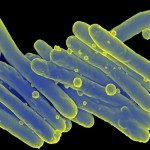Link to Pubmed [PMID] – 28720766
Sci Rep 2017 07;7(1):5702
Tuberculosis (TB) is a deadly infectious disease, which kills millions of people every year. The causative pathogen, Mycobacterium tuberculosis (MTB), is estimated to have infected up to a third of the world’s population; however, only approximately 10% of infected healthy individuals progress to active TB. Despite evidence for heritability, it is not currently possible to predict who may develop TB. To explore approaches to classify susceptibility to TB, we infected with MTB dendritic cells (DCs) from putatively resistant individuals diagnosed with latent TB, and from susceptible individuals that had recovered from active TB. We measured gene expression levels in infected and non-infected cells and found hundreds of differentially expressed genes between susceptible and resistant individuals in the non-infected cells. We further found that genetic polymorphisms nearby the differentially expressed genes between susceptible and resistant individuals are more likely to be associated with TB susceptibility in published GWAS data. Lastly, we trained a classifier based on the gene expression levels in the non-infected cells, and demonstrated reasonable performance on our data and an independent data set. Overall, our promising results from this small study suggest that training a classifier on a larger cohort may enable us to accurately predict TB susceptibility.

